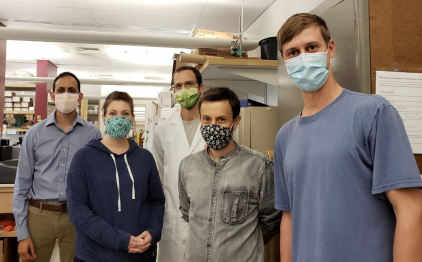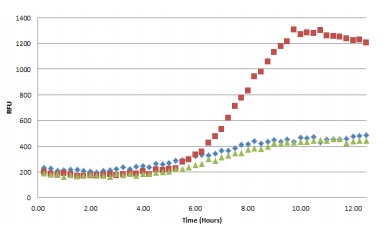 Dr. Jean-Paul Toussaint, Class of 2021 Pictured at far right, with lab members (Left to right): Ajai Dandekar, MD PhD, Nicole Smalley, Kyle Asfahl PhD, Maxim Kostylev PhD
Dr. Jean-Paul Toussaint, Class of 2021 Pictured at far right, with lab members (Left to right): Ajai Dandekar, MD PhD, Nicole Smalley, Kyle Asfahl PhD, Maxim Kostylev PhD
Pseudomonas aeruginosa is an antibiotic-resistant bacterium that causes serious infections predominantly in the lungs, but also in blood and the urinary tract.
Through a process called Quorum Sensing (QS), the bacteria release diffusible molecules that stimulate adjacent bacteria to express cellular products important for their growth and virulence. Once the Pseudomonas colony reaches a certain density, genetically regulated QS signals auto-induce a more pathogenetic phenotype. QS inhibitors are being considered as potential therapies for P. aeruginosa infections. Dr. Toussaint and colleagues hypothesized that presence of a QS inhibitor would select for P. aeruginosa with QS gene mutations. Knowing that urine contains a natural QS inhibitor (urea), they sequenced the lasR gene in P. aeruginosa isolated from 39 clinical urine samples and found that QS gene adaptations are more common than previously suspected.
To further test the hypothesis, Dr. Toussaint will perform evolution experiments to compare the development of lasR mutations with versus without QS inhibitors.
Two genes that encode QS, lasl and rhIA are regulated by lasR and RhIR. The figure below demonstrates a breakdown in the traditional QS hierarchy that regulates virulence. This figures demonstrates that RhIR regulates QS independently of LasR within a urinary isolate: there is high rhIA activity (rhla-GFP expression, in red) despite a nonfunctional lasR mutation (no lasl-GFP expression, in blue, and no expression from the negative control, in green).

Dr. Toussaint would like to acknowledge his mentor, Dr. Dandekar, and collaborators who are shown in the photo.
Dr. Toussaint will graduate from residency in 2021 and is planning a career as basic science investigator in the fields of pulmonary and critical care medicine.


